- Thread starter
- #61
Navigation
Install the app
How to install the app on iOS
How To Use Progressive Web App aka PWA On 420 Magazine Forum
Note: This feature may not be available in some browsers.
More options
You are using an out of date browser. It may not display this or other websites correctly.
You should upgrade or use an alternative browser.
You should upgrade or use an alternative browser.
Barney's Pineapple Express - Help
- Thread starter Kevzino
- Start date
- Thread starter
- #62
- Thread starter
- #64
Best bets get some lst going my plants would be huge if I didn't lst them you get more yield and good buds from the light penetration plus autos tend to be shorted anyway YouTube or google the sea of green that's the auto flower version of scrog(screen of green)
Hey bro I know what you mean if I LST them but in turn isn't that marking them grow bigger I want them to grow about 50cm and just bud completely after that. My tent space isn't too big so I don't want it to get to a point where I can't control it because it's so big and I understand that if I trim the plant it looses the buds potency.
Hey bro I know what you mean if I LST them but in turn isn't that marking them grow bigger I want them to grow about 50cm and just bud completely after that. My tent space isn't too big so I don't want it to get to a point where I can't control it because it's so big and I understand that if I trim the plant it looses the buds potency.
Looks up in this forum 250w refrigerator grow am guess his fridge will be similar size buddy
Hey bro I know what you mean if I LST them but in turn isn't that marking them grow bigger I want them to grow about 50cm and just bud completely after that. My tent space isn't too big so I don't want it to get to a point where I can't control it because it's so big and I understand that if I trim the plant it looses the buds potency.
Some more helpful info here mate I ran into a ppm panic today as mine reached 1300 which is bad you want it around 600-1000 but your plants will get nutrient burn and eventually die if it's at 1400+ av put a link below so you can learn more about ph and ppm as its to do with your water and nutrients for the soil when you finally can start adding some
Come see my journey as I'm in flowering on photos
Anyone's welcome and you are handed a joint at the door and a bean bag thrown where ever you want it
Wanted A Journal But Don't Know How To Start
Wanted A Journal But Don't Know How To Start
Anyone's welcome and you are handed a joint at the door and a bean bag thrown where ever you want it
Wanted A Journal But Don't Know How To Start
Wanted A Journal But Don't Know How To Start
Skybound
Well-Known Member
Regarding PPM, there are two different conversion ratios that different meter manufacturers use when building the meter. You'll need to research this further as I forgot most of the particulars, but essentially PPM is to be interpreted differently depending on which meter you use. I do know the two popular conversion ratios are 0.5 and 0.7. So meter A may reading 1400 while meter B reads like 900. I personally don't see how this can be so as PPM stands for parts per million, so how can one say 900 while the other say 1400 and some how both are correct? None the less, become familiar with the process of how your meter converts electrical continuity (EC) into PPM.
Regarding PPM, there are two different conversion ratios that different meter manufacturers use when building the meter. You'll need to research this further as I forgot most of the particulars, but essentially PPM is to be interpreted differently depending on which meter you use. I do know the two popular conversion ratios are 0.5 and 0.7. So meter A may reading 1400 while meter B reads like 900. I personally don't see how this can be so as PPM stands for parts per million, so how can one say 900 while the other say 1400 and some how both are correct? None the less, become familiar with the process of how your meter converts electrical continuity (EC) into PPM.
I'm new to growing but been taught by a grower and do a lot of research am glad you mentioned that as I didn't read up on mine till you said it .
In the ppm thing I posted covers the majority I just saw someone who needed answers as a new grower and as I know thru going thru my first lovely time it's a panicking process but if you research as much as you can and do everything you can do with the knowledge then only good things can come of it that and trial and error are the best ways to learn
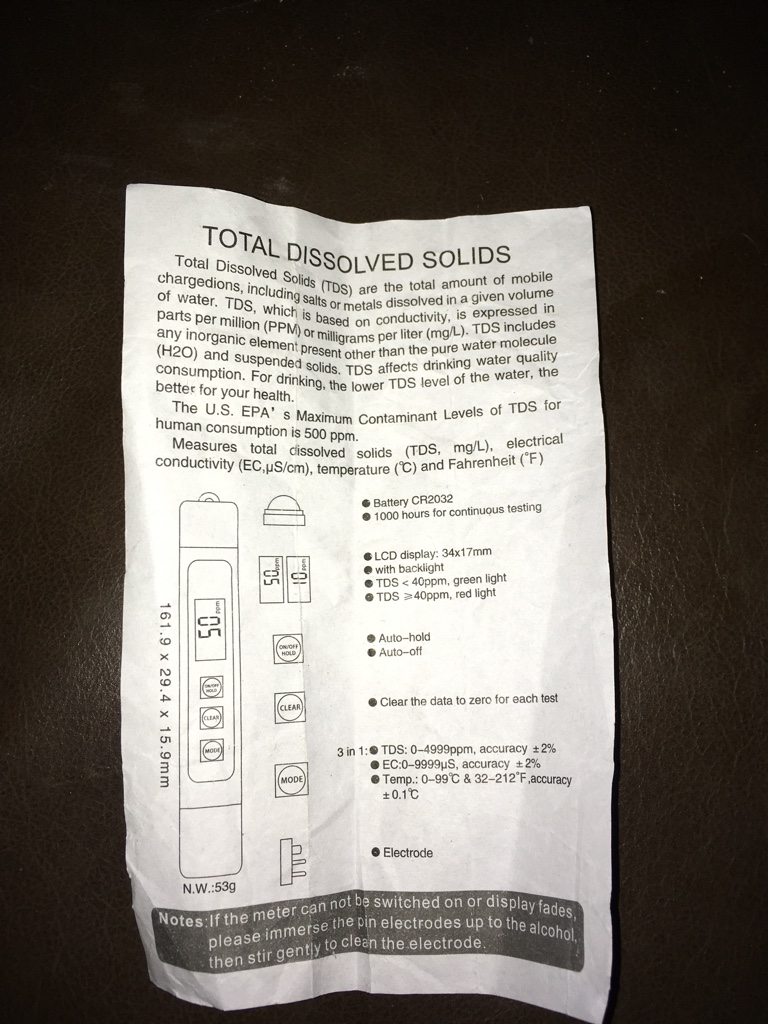
Obviously I know you know your stuff skybound but as I'm on all day as the app pushes messages to my phone I'm subscribed too this so he needed answer and I gave him as much advise I could and as my plants are doing alright and looking I think lovely . I thought the stuff I know can't do any harm sharing .
Skybound
Well-Known Member
All's good Robbo, I didn't mean to come off conflicting, but rather wanted to inject more info on the topic of PPM. We all interpret PPM correctly, but the meters themselves might be feeding us different readings. FWIW, most meters use the .5 ratio, but still, there's the .7s out there too.
All's good Robbo, I didn't mean to come off conflicting, but rather wanted to inject more info on the topic of PPM. We all interpret PPM correctly, but the meters themselves might be feeding us different readings. FWIW, most meters use the .5 ratio, but still, there's the .7s out there too.
No I thought the same when I was replying that I may of been offensive
It's the only was us men can get our information out we all know everyone's trying to help it's a good community on here
All's good Robbo, I didn't mean to come off conflicting, but rather wanted to inject more info on the topic of PPM. We all interpret PPM correctly, but the meters themselves might be feeding us different readings. FWIW, most meters use the .5 ratio, but still, there's the .7s out there too.
I found out after you said that mine read .49 so call I .5 does that mean I half what it's says? Cause it's gone and confused me with it but I know your right cause I got my instructions here but it don't mention anything in detail
Skybound
Well-Known Member
What is the Connection Between EC and TDS in a Hydroponics System?
TDS meters are really EC meters in disguise. A TDS meter reads the EC of the dissolved salts in the solution and uses a conversion factor to provide a ppm reading. Let’s say the EC is 2,200 microsiemens.
Some dissolved salts with an EC of 2,200 microsiemens will have a ppm of 1,540 (I used a conversion factor of 0.7), but this does not mean the solution you measured has that 1,540 ppm.
A conversion factor is a known value used as a multiplier for converting a quantity expressed in one set of units into an equivalent value expressed in another set of units. The conversion factor depends on what the salt solution is; it could be the correct conversion factor, but that is unlikely.
The relationship of TDS and EC can be approximated by the following equation:
TDS = keEC
In this equation, TDS is expressed in milligrams or liters and EC in microsiemens per centimeter at 77°F. The correction factor ke usually varies between 0.55 and 0.8, and is specific to each salt. When you have a mixture of salts, such as in a feeding solution, a correction factor that will emulate that mixture should be used.
EC meters that read as TDS (ppm) often use a correction factor of 0.5 or 0.7, depending on the meter being used. Because it uses a pre-set conversion factor instead of one specific to the solution, the reading is less accurate than it could be.
When comparing ppm readings with another grower, check to make sure you are both using meters with the same conversion factor. Also mind your temperatures because the temperature of a nutrient solution will cause the EC reading to change. A higher temperature will generally give a higher reading.
In a growing situation, the temperature differences and the effect on the EC is usually not significant enough to matter, and most meters these days are temperature-compensating so the grower does not have to manually make adjustments. As the temperature changes, the meter makes an adjustment in the reading to compensate. The meter manual will state what temperature is used as the base; often 77°F is used, such as with the above example.
Understanding EC, TDS and PPM
Edit - I found a link to this article on HM's website
Understanding EC, TDS and PPM
Edit - I found a link to this article on HM's website
Thank you that made a good read
Basically says what you said which is why I struggled finding someone who was releasing ppm how ever I messed up today and started a post on it where my ppm meter reads 1307.which is double it was on am hoping it don't hurt crop so illness keeping close eye on for her
Yes lst them babies.Best bets get some lst going my plants would be huge if I didn't lst them you get more yield and good buds from the light penetration plus autos tend to be shorted anyway YouTube or google the sea of green that's the auto flower version of scrog(screen of green)
Yes lst them babies.
Ive grown like 6 vertical nodes of the main stem on just one stem thru lst can't wait to see em fill output there short then the big chunk what usually stood up in the middle ends up horizontal if you can am I correct joe?
Yeah its complexes to explain . Just pay attention to them look for signs. Note soon as you see pistils drop them lights bud. Watch for Intensity burn light stress then back off few inches. Keep the top of bud and be ween light around 73-78 I'm finding .Ive grown like 6 vertical nodes of the main stem on just one stem thru lst can't wait to see em fill output there short then the big chunk what usually stood up in the middle ends up horizontal if you can am I correct joe?
Update (Day 14) - haven't done anything apart from giving both plants about a quarter of a litre of water to share just because the top was quite dry didn't give it to much water just enough to wet the top.
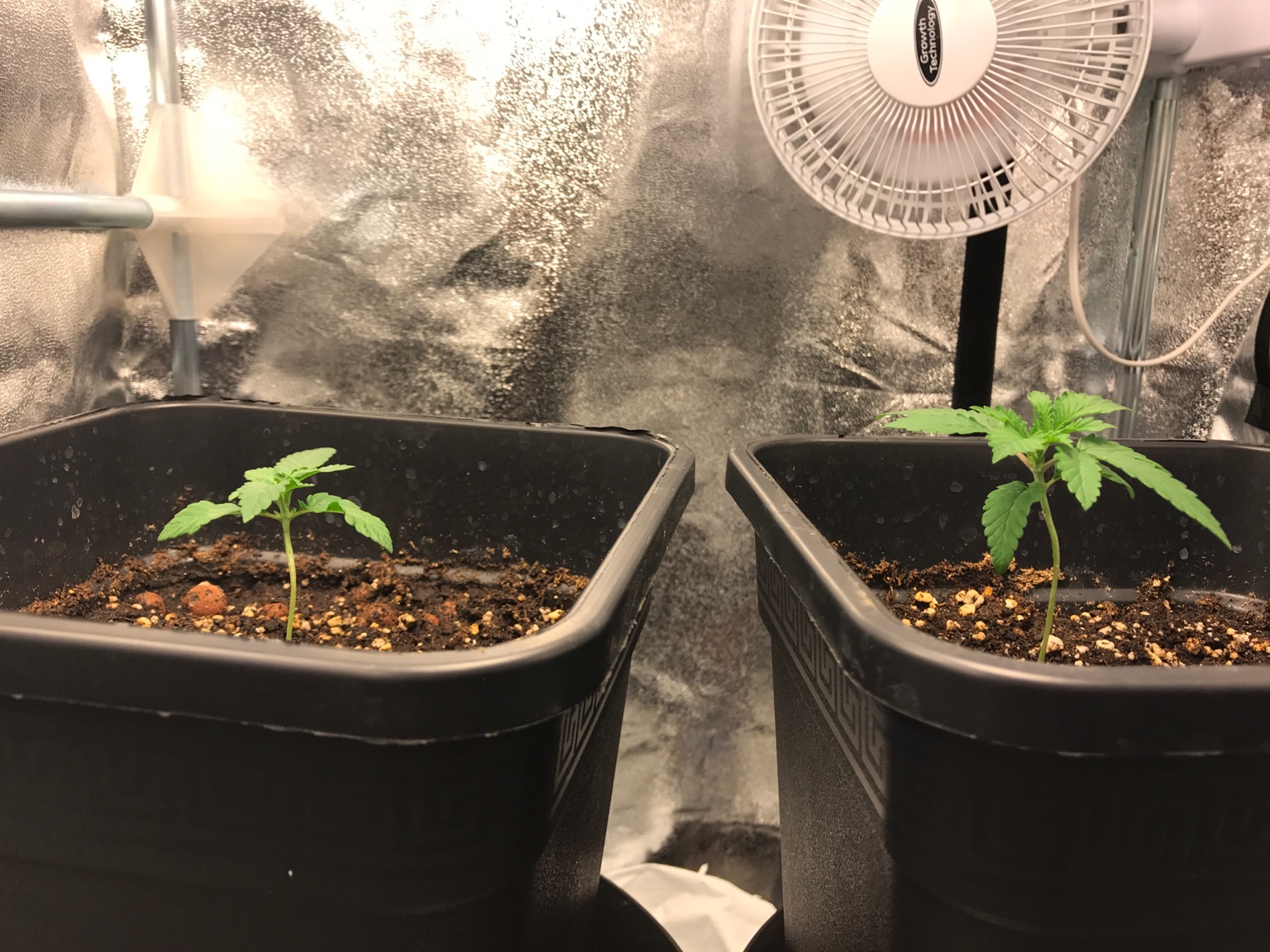
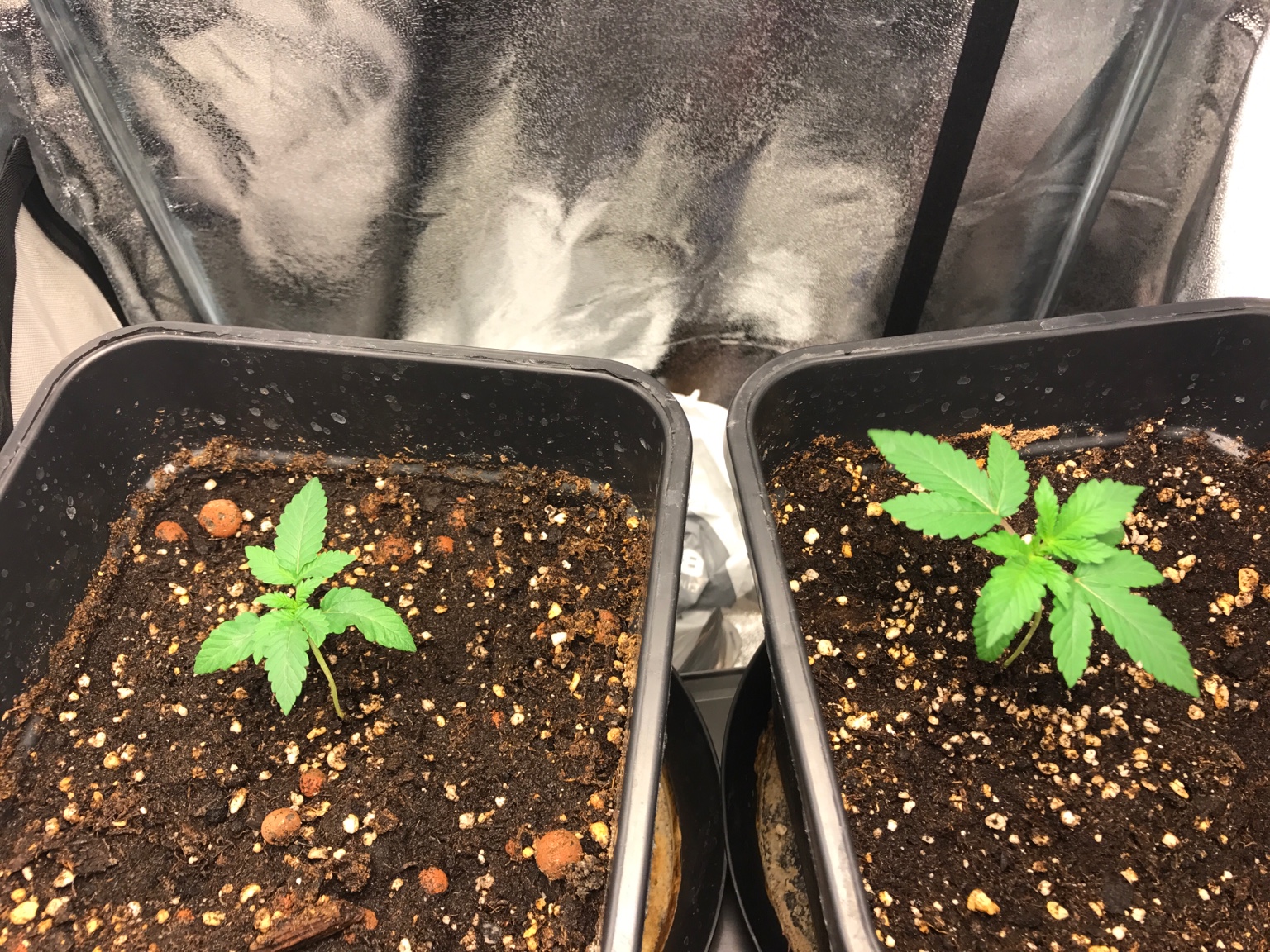
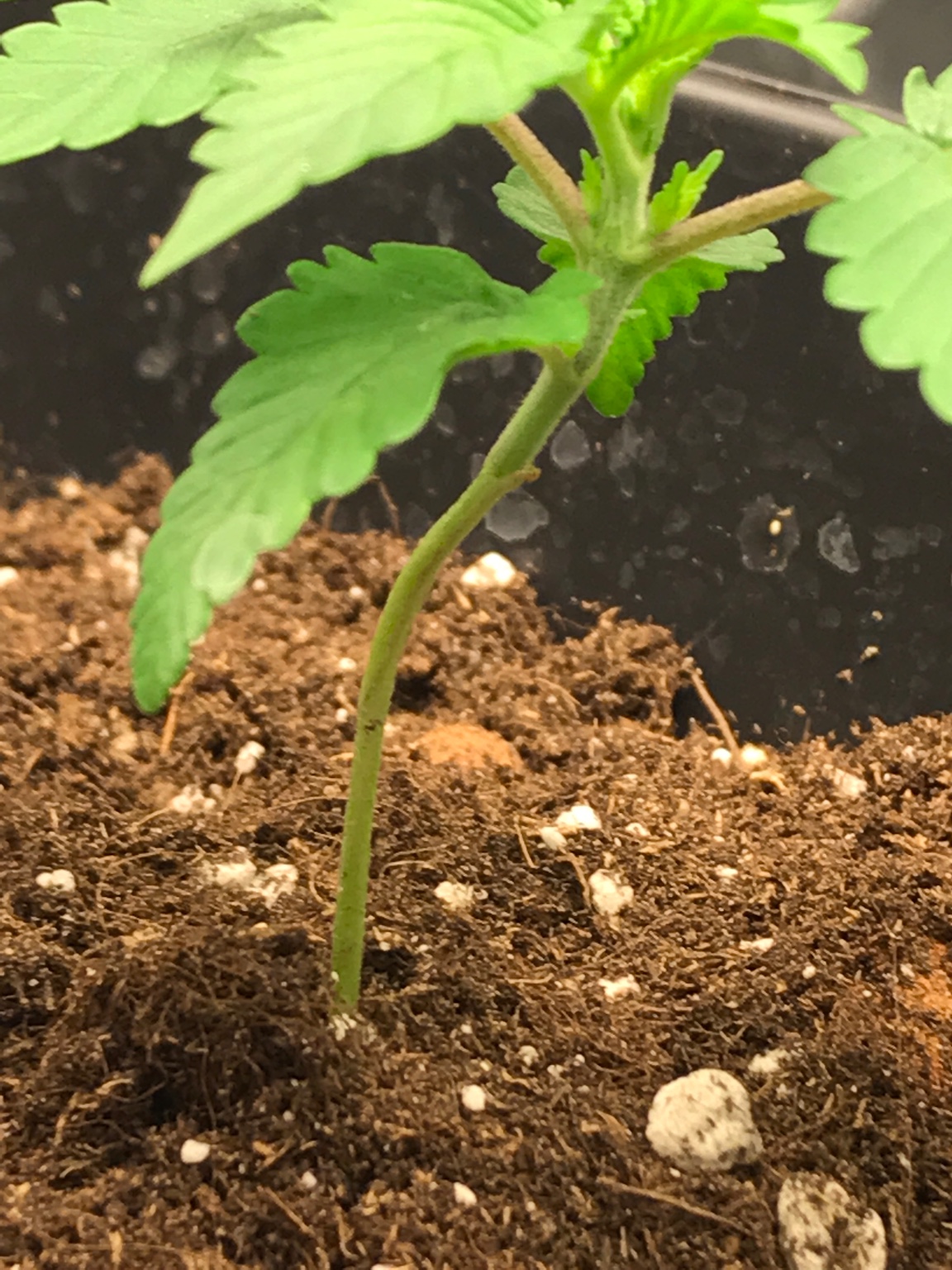
My fan leaves are drooping.... what problem is this????
KevTxr - You really reall need to resist the urge to do everything.
Your plants did not need water. You gave them some water. What does that mean?
One answer: You may have caused the roots to be lazy and not grow deep.
Another answer: You may have encouraged mold or other stuff to grow in the surface of the soil.
Your plant did not need extra soil, but you added extra soil. What does that mean?
One answer: You have slowed growth for a couple of days as your plant spends energy growing roots higher on the stem.
There is talk about nutes: If you add nutes, what will happen?
one answer: You might kill your plant.
- - - - -
The things that would help right now are:
Get yourself a cheap weather station to measure high/low temperatures and high/low humidity. These values help a plant grow more than nutes.
A cheap weather monitor (try to keep it cleaner than I do.)
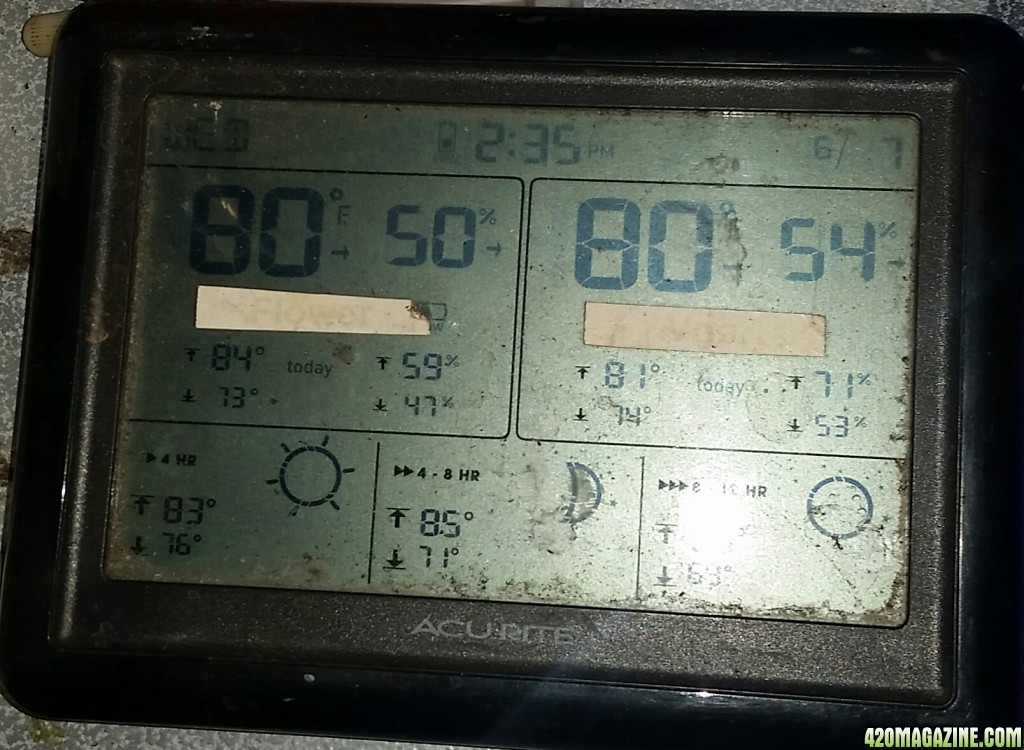
Find out how good your water is - Are you using tap water? Have you looked at the water report from your local utility? (it's online.)
What do you do about the chlorine in the water?
How far away are you lights?
I usually start with CFLs about 4-5 inches above the canopy of the seedling. As the plants grow, I let them get to 2 inches from the light. By the time they get to 4 nodes they are 1-2 inches away from the light.
p.s. all this stuff about PPM doesn't apply to your plants growing in soil
.
Similar threads
- Replies
- 4
- Views
- 7K
- Replies
- 33
- Views
- 5K


